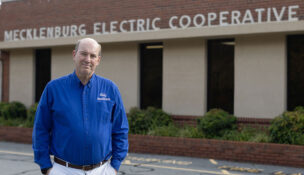SWVA ‘ideal’ for small nuclear reactors, study says
Seven potential sites identified in region
SWVA ‘ideal’ for small nuclear reactors, study says
Seven potential sites identified in region
Sites in Dickenson, Lee, Scott and Wise counties and the city of Norton would be “ideal” for installing small modular nuclear reactors (SMRs), according to a state-funded feasibility study released Monday.
Examining the technical feasibility, safety considerations and economic viability of locating small reactors in Southwest Virginia, the study conducted by Reston-based Dominion Engineering Inc. deemed Southwest Virginia a “competitive hosting ground for SMRs.”
The region is “in a prime position to attract new industries with inexpensive brownfield sites, mine water for cooling, existing right of way to transmission infrastructure and existing rail infrastructure,” according to the $150,000 study, which was commissioned by the LENOWISCO Planning District Commission and funded by the Virginia Department of Energy and GO Virginia Region One.
“The main takeaway,” said Dominion Engineering President Mike Little, “is that this community is extremely attractive for one of these facilities. It’s not just one … factor that makes it attractive. It’s broadly distributed across all of those categories. … There’s existing infrastructure here.”
The state-funded study bolsters Virginia Gov. Glenn Youngkin’s push for nuclear energy to be part of the state’s green energy framework, the Virginia Clean Economy Act, which was passed by the General Assembly in 2020. In October 2022, Youngkin announced a goal of bringing a small nuclear reactor to Southwest Virginia within 10 years — despite the fact that the only currently operational SMR is in Russia. The idea of nuclear energy being a bridge between fossil fuels and renewable solar and wind energy sources has support from both Republicans and Democrats.
Last fall, Youngkin proposed allocating $10 million to create the Virginia Power Innovation Fund, with $5 million going toward the development of an SMR, but the legislature isn’t completely on board. A bill to establish a small nuclear reactor pilot program failed in the General Assembly this session, but nuclear energy is still a hot topic among state energy stakeholders.
“The study affirms the governor’s initiative to deploy SMRs in Southwest Virginia and their advantage in the region,” Youngkin’s spokeswoman, Macaulay Porter, said this week. “As the governor has said, the Southwest has a talented, generational energy workforce, a best-in-class training pipeline through local colleges and community colleges, and a unique geography that makes it among the best locations for research and development of advanced nuclear technologies.”
The seven potential SMR sites identified by the study are:
- Bullitt Mine Complex, Wise County
- Vacant limestone mine, Scott County
- Abandoned mine land site, Lee County near Wise County border
- Mineral Gap/Lonesome Pine Regional Business and Technology Park, Wise County
- Project Intersection (188-acre surface coal mine site at U.S. 23 and U.S. Alt 58), Norton
- Red Onion Industrial Park, Dickenson County
- Virginia City Hybrid Energy Center power station, St. Paul
In a statement Monday, Virginia House Majority Leader Terry Kilgore, R-Gate City, called the site and feasibility study “the next step in making Gov. Youngkin’s ‘moonshot’ goal of making Southwest Virginia the home of the nation’s first SMR within 10 years a reality.”
The two major utilities providing power in Virginia — Richmond-based Dominion Energy Inc. and American Electric Power Inc. (AEP) — have expressed support for developing nuclear projects in the region, according to the study. In a plan released in January, Dominion stated that it “anticipates SMRs could be a feasible supply-side resource as soon as the 2030s.”
At least 70 commercial SMRs are in various stages of development worldwide, but only one in Russia is operational. In the United States, the U.S. Nuclear Regulatory Commission approved just one SMR design, from Oregon-based NuScale Power Corp., in summer 2022.
SMRs are designed to generate up to 300 megawatts per unit, about one-third of the capacity of conventional nuclear reactors, such as the North Anna and Surry power stations owned by Dominion Energy Inc. in Virginia, which power nearly 900,000 homes.
Supporters see SMRs as a solution to climate change because they don’t emit greenhouse gases, unlike gas- and coal-fueled power plants. And unlike wind or solar energy, nuclear reactors aren’t dependent on the elements and don’t require battery storage. However, critics say that large nuclear plants are too expensive to build and maintain, and it will take too long for SMRs to address climate change, as well as prompting safety concerns about radioactive waste and accidents.
A May 2022 study led by a Stanford University scientist published in the Proceedings of the National Academy of Sciences found that SMRs would likely create more nuclear waste — by a factor of up to 30 — than conventional reactors. However, a second study released in November 2022 by the Argonne and Idaho national labs said the amount of nuclear waste produced by SMRs would be about the same as waste produced by large light water reactors.
Virginia’s study on the viability of Southwest Virginia as a future home for SMRs “gives us third-party validation that Southwest Virginia is in the running, based on the land attributes necessary for deployment of SMRs,” said Will Payne, managing partner of consulting firm Coalfield Strategies LLC and head of business development for InvestSWVA, a regional business attraction campaign that focuses on adapted reuses for abandoned mine land.
“Southwest Virginia has and always will be an energy community,” Payne said, “and we believe that our land position makes us more competitive than other energy communities around the country.”
The primary reason many Southwest Virginia stakeholders are keen on SMRs is the economic impact such a project could have on the region. With the decline of coal mining jobs in Appalachia, the Southwest region has lost good-paying jobs and seen its population numbers decrease as a result.
“It’s fair to say deploying one SMR will absolutely transform this region’s economy because of the significant capital investment,” Payne said.
A 300-megawatt SMR would be expected to require a capital expenditure of about $1 billion, creating 40 to 60 permanent jobs and hundreds of temporary construction jobs, according to the study, and would provide more than $100 million in new local tax revenue over about 20 years. However, the report also confirmed that it could take 10 years for the first SMR to be operational in the region.
“We are thrilled to have completed this study, which holds great promise for transforming the energy landscape not only in Southwest Virginia but throughout the commonwealth of Virginia,” LENOWISCO executive director Duane Miller said in a statement. “Small modular reactors have the potential to provide a source of safe, stable and sustainable energy, enabling transformational economic growth, improving quality of life and complementing the region’s existing energy generating portfolio.”
T
















